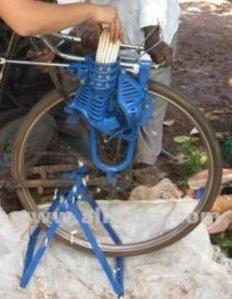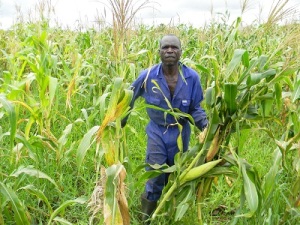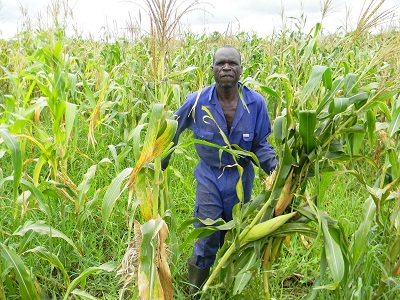 Agro-technologists have over the years scaled up efforts to develop technologies to relieve farmers from labour constraints in food production processes. But it appears until recently, the attention has always been on the medium and large scale farmers at the neglect of smallholder farmers who contribute immensely to the world’s total food production.
Agro-technologists have over the years scaled up efforts to develop technologies to relieve farmers from labour constraints in food production processes. But it appears until recently, the attention has always been on the medium and large scale farmers at the neglect of smallholder farmers who contribute immensely to the world’s total food production.
According to the International Fund for Agricultural Development (IFAD), a specialized agency of the United Nations, smallholder farmers manage approximately 500 million small farms and provide over 80 per cent of the food consumed in large parts of the developing world.
A new United Nations’ report released recently emphasised that supporting smallholder farmers to play a greater role in food production is one of the quickest ways to lift over one billion people out of poverty and sustainably nourish a growing world population.
Experts say food security in Ghana is largely dependent on the contribution of smallholder farmers predominantly engaged in crop and cash production. Majority of them are still using primitive farming and harvest methods and laborious post-harvest processes.
Shelling maize crop by hand is one of the labour intensive and time consuming processes. This arduous process is not uncommon to maize farmers in the remote parts of Ghana, particularly those in the northern part of the country, who cannot afford tractor services to shell their produce.
However, it seems there is some kind of relief beaming on sight. Maize farmers in the Northern region, especially the smallholder farmers, will soon reduce labour cost and time of shelling their produce after harvest.
This is because the implementing agency of Feed the Future USAID Agriculture Technology Transfer project, International Fertiliser Development Center (IFDC), has discovered a less labour intensive and time saving technology for maize farmers in the project catchment area.

It is a simple maize sheller mounted on bicycle with a multiple mobile phone charging cell attached. As the user pedals to power the bicycle, two things are achieved; charging about four mobile phones at a time and shelling the maize. It requires only two people; one to pedal the bicycle and an assistant to drop the cobs of maize inside the sheller.
With this maize sheller bicycle kit, the farmer can fill a 90-kg sack of maize in 40 minutes and 10 to 15 sacks per day. The bicycle retains full functionality for transport and carrying loads. The shelling kit is easy to install, remove and reattach. It works with most common models of bicycle in local villages.
IFDC recently demonstrated how the technology works to some farmer groups in and around Nyankpala, working with some agrobusiness companies in the Northern region.
Farmers who witnessed the demonstration at the premises of Savanna Seed Company were more than happy. To them, this technology has come to eliminate the burden of looking for labour and the time involved in shelling their maize.
Mr Taylor Salifu Musa, the Organisation Development Advisor to Feed the Future USAID Agriculture Technology Transfer Project (ATT), says the introduction of the technology is in line with the project’s goal of increasing the availability of appropriate and affordable farming technologies to farmers in northern Ghana.
Mr Musa noted that the technology would not be useful to only farmers but also provide employment opportunities for the rural unemployed youth. “The youth can take it upon themselves acquire these maize sheller bicycle kits, visit communities and shell farmers maize for a fee”, he said.
The bicycle powered maize sheller is not on the Ghanaian market yet but it has been accepted and adapted by maize farmers in Tanzania, and abundant in China. Though useful, IFDC does not intend to impose the technology on farmers.
The organisation recently imported few of the shelling kits and mobile charging units, presented them to seed companies and farmer groups to whip up farmers interest and acceptance before it ensures the availability of the technology on the Ghanaian market.
Mr Taylor hinted his outfit could collaborate with Gratis Foundation and the original manufacturer to make them available to farmers.
Seed Moisture tester is another simple hand tool being introduced under the Feed the Future USAID Agriculture Technology Transfer Project (ATT) project. With this gadget, the rice farmers are able to determine the moisture level of their seeds and also select quality seeds.
Savanna Seed Company and Shekina Center have received two of the bicycle shellers as well as the seed moisture testers and are expected to carry out further demonstration exercises in the remote communities.
The Agriculture Technology Transfer (ATT) project is has an ultimate goal of improving agricultural productivity and growth. This involves development, availability and adoption of agricultural technologies here in Northern Ghana. Over the next half decade, there are a number of activities planned to reach over 100,000 farmers, who are into maize, rice, and soya production in Northern Ghana, through public and private sector partnership

